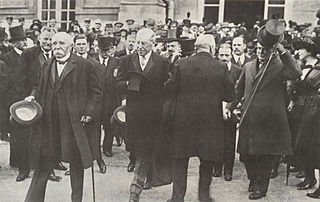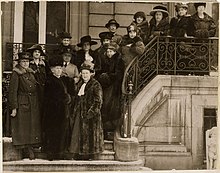
The Treaty of Versailles was a peace treaty signed on 28 June 1919. One of the most important treaties of World War I, it ended the state of war between Germany and the Allied Powers. It was signed in the Palace of Versailles, exactly five years after the assassination of Archduke Franz Ferdinand, which led to the war. The other Central Powers on the German side signed separate treaties. Although the armistice of 11 November 1918 ended the actual fighting, it took six months of Allied negotiations at the Paris Peace Conference to conclude the peace treaty. The treaty was registered by the Secretariat of the League of Nations on 21 October 1919.
Andorra, officially the Principality of Andorra, also called the Principality of the Valleys of Andorra, is a sovereign landlocked microstate in Southwestern Europe, located in the eastern Pyrenees mountains and bordered by Spain and France.
Treaty of Paris may refer to one of many treaties signed in Paris, France:

The San Remo conference was an international meeting of the post-World War I Allied Supreme Council as an outgrowth of the Paris Peace Conference, held at Castle Devachan in Sanremo, Italy, from 19 to 26 April 1920. The San Remo Resolution passed on 25 April 1920 determined the allocation of Class "A" League of Nations mandates for the administration of three then-undefined Ottoman territories in the Middle East: "Palestine", "Syria" and "Mesopotamia". The boundaries of the three territories were "to be determined [at a later date] by the Principal Allied Powers", leaving the status of outlying areas such as Zor and Transjordan unclear.

The Fourteen Points was a statement of principles for peace that was to be used for peace negotiations in order to end World War I. The principles were outlined in a January 8, 1918 speech on war aims and peace terms to the United States Congress by President Woodrow Wilson. However, his main Allied colleagues were skeptical of the applicability of Wilsonian idealism.

The Treaty of Trianon was prepared at the Paris Peace Conference and was signed in the Grand Trianon château in Versailles on 4 June 1920. It formally ended World War I between most of the Allies of World War I and the Kingdom of Hungary. French diplomats played the major role in designing the treaty, with a view to establishing a French-led coalition of the newly formed states. It regulated the status of the Kingdom of Hungary and defined its borders generally within the ceasefire lines established in November–December 1918 and left Hungary as a landlocked state that included 93,073 square kilometres (35,936 sq mi), 28% of the 325,411 square kilometres (125,642 sq mi) that had constituted the pre-war Kingdom of Hungary. The truncated kingdom had a population of 7.6 million, 36% compared to the pre-war kingdom's population of 20.9 million. Though the areas that were allocated to neighbouring countries had a majority of non-Hungarians, in them lived 3.3 million Hungarians – 31% of the Hungarians – who then became minorities. The treaty limited Hungary's army to 35,000 officers and men, and the Austro-Hungarian Navy ceased to exist. These decisions and their consequences have been the cause of deep resentment in Hungary ever since.

The Paris Peace Conference was the formal meeting in 1919 and 1920 of the victorious Allies after the end of World War I to set the peace terms for the defeated Central Powers. Dominated by the leaders of Britain, France, the United States and Italy, it resulted in five treaties that rearranged the maps of Europe and parts of Asia, Africa and the Pacific Islands, and also imposed financial penalties. Germany and the other losing nations had no voice in the Conference's deliberations; this gave rise to political resentments that lasted for decades.

The Treaty of Sèvres was a 1920 treaty signed between the Allies of World War I and the Ottoman Empire. The treaty ceded large parts of Ottoman territory to France, the United Kingdom, Greece and Italy, as well as creating large occupation zones within the Ottoman Empire. It was one of a series of treaties that the Central Powers signed with the Allied Powers after their defeat in World War I. Hostilities had already ended with the Armistice of Mudros.

Ulrich Karl Christian Graf von Brockdorff-Rantzau was a German diplomat who became the first Foreign Minister of the Weimar Republic. In that capacity, he led the German delegation at the Paris Peace Conference but resigned over the signing of the Treaty of Versailles. He was also the German ambassador to the Soviet Union from 1922 to 1928.

The Armistice of 11 November 1918 was the armistice signed at Le Francport near Compiègne that ended fighting on land, sea, and air in World War I between the Entente and their last remaining opponent, Germany. Previous armistices had been agreed with Bulgaria, the Ottoman Empire and Austria-Hungary. It was concluded after the German government sent a message to American president Woodrow Wilson to negotiate terms on the basis of a recent speech of his and the earlier declared "Fourteen Points", which later became the basis of the German surrender at the Paris Peace Conference, which took place the following year.
Article 231, often known as the War Guilt Clause, was the opening article of the reparations section of the Treaty of Versailles, which ended the First World War between the German Empire and the Allied and Associated Powers. The article did not use the word "guilt" but it served as a legal basis to compel Germany to pay reparations for the war.
The Shandong Problem or Shandong Question was a dispute over Article 156 of the Treaty of Versailles in 1919, which dealt with the concession of the Shandong Peninsula. It was resolved in China's favor in 1922.

The partition of the Ottoman Empire was a geopolitical event that occurred after World War I and the occupation of Constantinople by British, French and Italian troops in November 1918. The partitioning was planned in several agreements made by the Allied Powers early in the course of World War I, notably the Sykes–Picot Agreement, after the Ottoman Empire had joined Germany to form the Ottoman–German Alliance. The huge conglomeration of territories and peoples that formerly comprised the Ottoman Empire was divided into several new states. The Ottoman Empire had been the leading Islamic state in geopolitical, cultural and ideological terms. The partitioning of the Ottoman Empire after the war led to the domination of the Middle East by Western powers such as Britain and France, and saw the creation of the modern Arab world and the Republic of Turkey. Resistance to the influence of these powers came from the Turkish National Movement but did not become widespread in the other post-Ottoman states until the period of rapid decolonization after World War II.

Little Treaty of Versailles or the Polish Minority Treaty was one of the bilateral Minority Treaties signed between minor powers and the League of Nations in the aftermath of the First World War. The Polish treaty was signed on 28 June 1919, the same day as the main Treaty of Versailles was signed, which is the reason for one of its names. It was the first of the Minority Treaties and served as a template for the subsequent ones; together with Articles 87-93 of Treaty of Versailles, it also formally established Poland as a sovereign and independent state on the international arena.

Lou Tseng-Tsiang was a Chinese diplomat and a Roman Catholic priest and monk. He was twice Premier of the Republic of China and led his country's delegation at the Paris Peace Conference of 1919. He sometimes used the French name René Lou in earlier life, and his monastic name was Pierre-Célestin, O.S.B.

The Big Four or the Four Nations refer to the four top Allied powers of World War I and their leaders who met at the Paris Peace Conference in January 1919. The Big Four is also known as the Council of Four. It was composed of Georges Clemenceau of France, David Lloyd George of the United Kingdom, Vittorio Emanuele Orlando of Italy, and Woodrow Wilson of the United States.
The U.S.–German Peace Treaty was a peace treaty between the U.S. and the German governments. It was signed in Berlin on August 25, 1921 in the aftermath of World War I. The main reason for the conclusion of that treaty was the fact that the U.S. Senate did not consent to ratification of the multilateral peace treaty signed in Versailles, thus leading to a separate peace treaty. Ratifications were exchanged in Berlin on November 11, 1921, and the treaty became effective on the same day. The treaty was registered in League of Nations Treaty Series on August 12, 1922.
The United Kingdom declared war on Germany on 3 September 1939, two days after Germany invaded Poland. France also declared war on Germany later the same day.

The war guilt question is the public debate that took place in Germany for the most part during the Weimar Republic, to establish Germany's share of responsibility in the causes of the First World War. Structured in several phases, and largely determined by the impact of the Treaty of Versailles and the attitude of the victorious Allies, this debate also took place in other countries involved in the conflict, such as in the French Third Republic and the United Kingdom.

China participated in World War I from 1917 to 1918 in an alliance with the Entente Powers. Although China never sent troops overseas, 140,000 Chinese labourers served for both British and French forces before the end of the war. While neutral since 1914, Duan Qirui, Premier of the Republic of China, spearheaded Chinese involvement in World War I. Duan wanted to integrate China with Europe and the United States by declaring on the side of the Allies against the Central Powers. On 14 August 1917, China ended its neutrality, declaring war on the German Empire and the Austro-Hungarian Empire.



![Delegation from the Democratic Republic of Azerbaijan in Hotel Claridge [fr] during the Paris Peace Conference. Azerbaijani delegation in Paris.jpg](http://upload.wikimedia.org/wikipedia/commons/thumb/8/89/Azerbaijani_delegation_in_Paris.jpg/220px-Azerbaijani_delegation_in_Paris.jpg)















